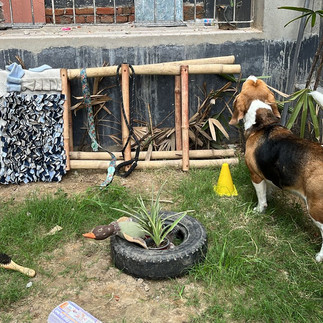All You Need To Know About Enrichment
- Surabhi Venkatesh
- Jul 19, 2022
- 4 min read
Some of the most commonly asked questions on enrichment spaces are answered here:
#1 What is enrichment?
Enrichment is facilitating activities for dogs for them to express their natural behaviours in a safe and secure environment. Behaviours like scavenging, chewing, digging, and sniffing - are all natural behaviours that are part of a dog's ethogram. When dogs don't get the opportunity to express these behaviours, it can lead to frustration and eventually "behavioural problems". Including enrichment activities in our dog's lifestyle allows us to meet their various emotional & behavioural needs.
#2 What is an enrichment setup?
An enrichment space is any physical space (your living room, garden) that is set up with an array of items for dogs. These are arranged in random order and are selected keeping in mind the 5 senses of touch, smell, sight, sound, and taste and other sensory needs like proprioception. In curating an enrichment space like this, the dog can access a wholesome sensory experience.
#3 How can enrichment help my dog?
Enrichment activities, when incorporated frequently into a dog's routine, can be extremely useful in building confidence and coping mechanisms. Take Mutton for example. She's a dog that experiences sensory overload on outdoor walks - this means she gets easily overwhelmed by sights, sounds, and smells, especially in busy surroundings. We incorporated indoor enrichment activities every day into her routine as a way for her to use her natural talents and build on new skills like problem-solving, thinking and decision-making. With consistent practice, we found that she was much calmer on her outdoor walks, was more confident, more trusting of us and was becoming better adjusted to her new home.

For dogs that are nervous/anxious/fearful/struggle with social situations, enrichment activities and setups can provide a much-needed opportunity to slow down and explore the 'world' at their own pace and time. The same works for hyper or overly excited dogs. Sniffing activates regions in the brain that help release the dopamine hormone. Dopamine or the 'feel good' hormone is essential for mood regulation, improving focus and attention, supporting learning, memory, and overall cognition. You might be able to see how providing opportunities to sniff can help not just reduce stress levels in a dog but also help build a thinking dog.

Enrichment setups can also provide opportunities for dogs to practice functional movement. Most dogs engage in extremely adrenalizing activities like fetch and tug that require more effort than usual from their muscles and joints. Regular activities like these can put undue strain on these very muscles and joints, leading to poor movement, posture, joint and muscle conditions, and chronic pain. Functional movement on the other hand is an effortless, pain-free movement that supports the ability of the body to move muscles and joints in the way they are supposed to function. For dogs who struggle with arthritis, ligament tears, spondylosis, dysplasia, amputations, or older dogs whose mobility has slowed down, enrichment setups are spectacular in helping the body move, gently, slowly, and effortlessly.
#4 What all can you add to an enrichment setup?
Puzzles, dog-friendly herbs, and plants, day-to-day household items like mops, empty garbage bins, socks, empty toilet rolls, delivery boxes, unwashed clothes, borrowed items from other dogs like collars, harnesses, toys, blankets - all of these items and more can be part of an enrichment setup. It's always helpful to work with a professional to design these, especially in the beginning, to understand how these spaces are planned.
#5 Can you add food to an enrichment setup?
While a lot of people do add food, I recommend against it (unless absolutely needed). Food and treats are such valuable resources for dogs that the enrichment then only becomes about scavenging and "finding more food" rather than really leveraging all their senses. For a few dogs, they can also get extremely 'worked up' around food, and then this no longer becomes a slow, calming activity. And then of course there are dogs that might be anxious or reactive around food, which then puts the dog and others around them at potential risk.
#6 How often should my dog engage in enrichment activities?
There is no one size fits all answer to this. Some dogs might benefit from enrichment activities 3-4 times a week, some might need less. After a few trials with your dog, you will be able to identify the frequency better. But usually a 30-minute session once a week is a good starting point.
#7 What can I expect after an enrichment session?
Most dogs experience a state of calm and tiredness immediately after an enrichment session. Rightly so, since they have engaged their mind and body in a very deliberate manner for a sustained period. The important thing to remember about introducing enrichment into your dog's life is to make it part of a larger lifestyle - towards helping your dog be a calm, thinking dog with effective coping mechanisms. If outside of enrichment sessions, that effort isn't made, then these sessions too will stop proving fruitful after a point.
To book an enrichment session for your dog, drop us an email on luchisbowl@gmail.com


























Comments